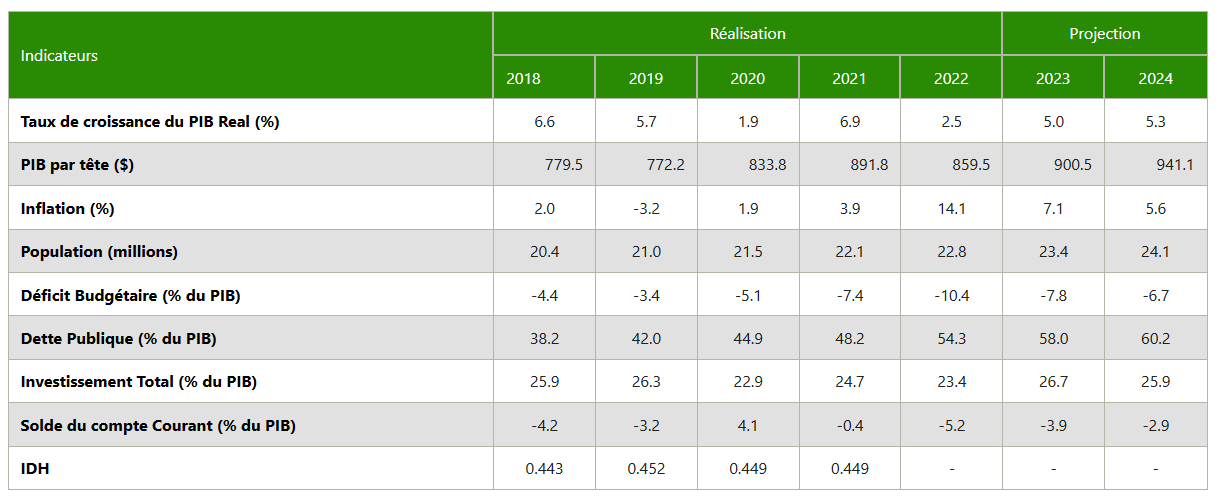 Macroeconomic Performance
Macroeconomic Performance
Table 1: Overview of some macroeconomic indicators
 Burkina Faso recorded an average growth rate of 4.7 per cent over the last five years. Burkina Faso’s economic activity grew by 2.5 per cent in 2022, compared to 6.9 per cent in 2021. The low growth is partly explained by the effects of the back-to-back overthrow of the government in eight months and the subsequent closure of borders with neighbouring countries, which has had a negative impact on the country’s trade, Furthermore, the Russia-Ukraine conflict triggered inflation, with the country’s a decade-high of 14.1 per cent in 2022, compared to 3.9 per cent in 2021. The fiscal deficit reached 10.4 per cent of GDP in 2022, compared to 7.4 per cent of GDP in 2021. The gross debt increased but remained below the 70 per cent of GDP threshold, i.e., 54.3 per cent of GDP in 2022, compared to 48.2 per cent of GDP in 2021. The current account deficit deteriorated further to 5.2 per cent of GDP in 2022 from 0.4 per cent of GDP in 2021.
Burkina Faso recorded an average growth rate of 4.7 per cent over the last five years. Burkina Faso’s economic activity grew by 2.5 per cent in 2022, compared to 6.9 per cent in 2021. The low growth is partly explained by the effects of the back-to-back overthrow of the government in eight months and the subsequent closure of borders with neighbouring countries, which has had a negative impact on the country’s trade, Furthermore, the Russia-Ukraine conflict triggered inflation, with the country’s a decade-high of 14.1 per cent in 2022, compared to 3.9 per cent in 2021. The fiscal deficit reached 10.4 per cent of GDP in 2022, compared to 7.4 per cent of GDP in 2021. The gross debt increased but remained below the 70 per cent of GDP threshold, i.e., 54.3 per cent of GDP in 2022, compared to 48.2 per cent of GDP in 2021. The current account deficit deteriorated further to 5.2 per cent of GDP in 2022 from 0.4 per cent of GDP in 2021.
Outlook
Burkina Faso’s economy is projected to grow at 5 per cent in 2023 and 5.3 per cent in 2024. Inflation is projected to fall but remain above the 3 per cent threshold in the WAEMU. The inflation rate is expected to fall from 7.1 per cent in 2023 to 5.6 per cent in 2024. The fiscal deficit is expected to narrow from 7.8 per cent of GDP in 2023 to 6.7 per cent in 2024. In contrast, gross debt is expected to continue its upward trend from 58 per cent of GDP in 2023 to 60.2 per cent of GDP in 2024. The current account deficit will decline from 3.9 per cent of GDP in 2023 to 2.9 per cent of GDP in 2024.
Probable Headwinds
The growing insecurity, due to terrorist attacks in the north, is a distraction to the growth in economic activity. Burkina Faso, like other countries in the sub-region, continues to be confronted with the threat of inflation. A resurgence in inflation will adversely affect the growth in economic activity. The country will face increased financing costs both domestically and in regional financial markets. Additionally, a poor rainfall pattern could deal a severe blow to the agriculture sector, which remains predominantly rain-fed. These factors could lead to a credit rating downgrade, which will further increase the cost of financing.

